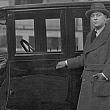Bringing the New Deal to Grand Rapids
Instead of short-term balloon payments, homeowners could finance properties through local banks at better rates and for longer loan periods. The Home Owner’s Loan Corporation (HOLC) initially offered amortized fifteen-year mortgages, meaning that the lump sum remained tied to a fixed rate of interest and spread out as equal payments across the life of the loan. Starting in 1933, the HOLC began to work with banks in Grand Rapids and across the United States to stabilize housing mortgages. Designed to work quickly with existing financial institutions, and on its own if necessary, the agency completed its lending by 1935. HOLC continued to exist until 1951 when it completed its mortgages and managed to turn a small profit.
Congress created the Federal Housing Administration (FHA) in 1934, through the National Housing Act, to serve as a long-term effort at setting national housing policy. In October 1935, the FHA took over from HOLC and began to work with reorganized banks, insurance companies, and individual homeowners to establish a formal, long-term restructuring of the housing market. Toledo, Ohio and Grand Rapids served as the first two cities to work with the new system with a result of over $2 million dollars in loans extended ($31 million in 2010 dollars) to Grand Rapids homeowners. After 1935, the FHA refined the loan term for the familiar thirty-year, amortized package.

 facebook
facebook



